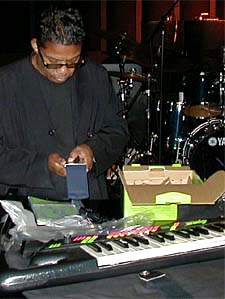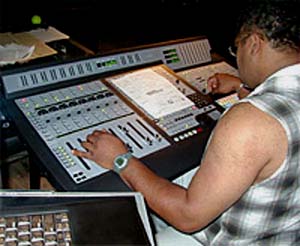When it comes to his
live performance setup, Herbie Hancock is no
stranger to innovation. At his concert in Hamburg,
you would have seen a PowerBook running
Logic
Audio, an
EMI 2/6 audio
interface, an MT4 MIDI interface, and virtual
instruments such as Emagic's EVP88
electric piano creating sound in real-time.
Herbie Hancock
: "We're doing
this tour to promote my new CD 'Future 2 Future'.
The music is unlike anything that I've ever done
before, as a matter of fact it's unlike anything
I've ever heard before. It's very hard to describe.
Although there are references to some of the new
kind of underground things that are happening in
music here at the beginning of the 21st century. We
have some references to bass, references to techno,
we're using some turntable , spoken word, vocals,
not on everything, every tune really has a
different sound. One thing that makes this tour
unique is that we're doing it using surround sound.
The other thing that makes this tour unique is that
we're also having a visual display. At this point
the visuals will probably maybe only be abstract
video, but on subsequent tours we hope to get a
little more elaborate than that and have some live
footage. We're going for it."
|

|
|
Future 2 Future
Live Musicians and Crew
Musicians:
Darryl Diaz (Keyboards), Terri Lyne Carrington
(Drummer), DJ Disc (DJ), Matthew Garrison ( Bass),
Wallace Roney (Trumpet)
Engineers:
David Mann (Front House Mixer), Gary Hirstus
(Monitor Mixer), Noel (Drum Technician), Dave
Hampton (Surround Sound Mixer, Keyboard
Technician)
|
TECHNOLOGY
Herbie's "Immersive
Mixing" Theory.
Immersive Mixing F2F Tour
Surround Sound Technology F2F Tour Hybrid System "Immersive
Mixing" is a term Herbie created to describe th application
of a "real world" approach to mixing in live performance and
in the studio. While doing presentations Herbie noted that
what was consistent throughout was the fact that when you're
in the real world, in real time as you live, you are
"immersed in sound", sound is happening all around you, you
do not have two speakers equal distance apart always
broadcasting audio to you as in your home stereo. So he
wanted to make the point of "immersive mixing" by taking it
one step further.
Surround Sound
Technology
 Dave
Hampton,
F2F Tour Surround Sound Mixer,
shares the exploration process. Dave
Hampton,
F2F Tour Surround Sound Mixer,
shares the exploration process.
"The concept of the tour was born out of Herbie's
conversations while doing keynotes speeches, addresses and
special functions, where we remixed some of his old material
what they call resourced the mixes for 5.1, which means we
took original stereo productions into the studio and remixed
them in surround sound.
During those presentations he worked very closely with
Thomlinson Holman who is the father of THX the motion
picture sound. What we found was that Herbie kept saying
this was just the beginning and where he eventually wanted
to see it go was to have live performance that was actually
done in surround sound. Probably about two years ago at the
AES show, Herbie did a keynote speech and at the conclusion
of the keynote speech we actually had the ability to have
Herbie play along with one of the track s that we had done
and actually fly him around the room and or have his sound
move around the room as he played it. And that basic keynote
speech was the test for what we're undertaking this summer
which was the Future 2 Future Tour.
So those presentations at AES were basically the test that
we were doing to first start to play with the idea of
actually performance in surround sound. From there we went
to resourcing more mixes. We went back in with Tom Holman we
did a 10.2 mix which involves a front and rear subroofer and
more side and rear listening point. And that was presented
at Consumer Electronic Show the very next year. That was
again well received. At that one we didn't do any live play
but off of the response we got we knew it was time to
undertake seriously doing performances and presentations in
surround sound.
Before that time surround sound was attempted with the use
of the Quad where they just have four stacks. We wanted to
take some of the concepts we learned from Tom Holman and
some of the concepts that we knew from traditional concert
playback and meld them into something that was acceptable
for the audience. Acceptable meaning we could do what we
wanted to do, in other words, fill the room and have key
elements and sounds and ambient tones and all kinds of
textures that accompany the music or are apart of the music
also going on while the performance is going on so that it
all actually melds into one. We were able to achieve that
through using two separate systems, we basically used a
traditional PA system and we used a special surround system
that we developed with DigiDesign and Protools. And that
basically allowed us to have two engineers, one who mixed a
regular show and one who mixed a surround show. While in
rehearsal for this we basically rented a room that's about a
little bit smaller than an airplane hanger. We set up
speakers in all the positions we needed, and set up our
regular house mix console and surround mix console, so that
while in rehearsal we could actually work through the moves
and hear sonically what the music was doing, how it was
filling, where it was filling and what it was doing. It's a
combination of things, so many things were predetermined. We
did a lot of rehearsal so that we knew the sections in the
song where we wanted to use elements. We didn't know exactly
where the elements were, we were leaving a lot of that up to
the musicians and leaving a lot of it up to the surround
mixer and the house mixer. The closest relationship would be
Dave Mann, who mixed front of house and myself who had a
whole separate dance we had to construct of show tunes, in
other words when we did a show it was basically a list of
tunes and all the predetermined moves that were going to
happen. We had an idea so at any time in the element of
music that we're doing the musicians can take off and do
anything they want, but because we know the general form of
the song, we have a general idea of what they were going to
do because Dave Mann who mixes house understands the eight
elements that I had, he understood that at any time I could
activate those eight within a certain framework. We
developed some paperwork and some way to protocol that would
happen so that we had one set of activity that was stereo
and one set of activity that basically templated over that
that equaled what we'll call the surround field. By using
that method we were able to meld the two together and have a
pleasantly well received performances in every city of our
version of live performance surround sound, what Herbie
calls 'Emersive Mixing'.
Some of the things we discovered though is that in that
element where the audience enjoys it and everybody hears it
and everything is great, the musicians are still challenged
because they now cannot hear in surround. So that's where
we're at this time and that's what's challenging us again
and we're going to try to come upwith something there. A lot
of that has to do though with having people think different,
which is what Herbie is a big proponent of. Trying to get
people to think outside the box, trying to get drummers to
not think like a drummer all the time, trying to get
keyboard players to not think like a keyboard player all the
time, trying to get people to come outside the box so they
can come with something new".
 Darryl
Diaz,
F2F Tour musical director and
keyboardist, explains how the
creation of a 'hybrid system' replaced their huge keyboard
racks. Darryl
Diaz,
F2F Tour musical director and
keyboardist, explains how the
creation of a 'hybrid system' replaced their huge keyboard
racks.
"We wanted to have the sound and sonic technique of loops
but didn't want to be locked into the form. We wanted to
have a real moving jazz approach. So what we created this
time was a hybrid system where the computers are generating
a lot of the sounds. I'm actually playing samples, vocal
samples and other key parts in real time from the keyboards
and we all have a rhythmic template to follow but we're not
locked into the form. So if we wanted to stay on a section
for 6 minutes or for 6 seconds, we have a choice. Ordinarily
we'd roll out with huge keyboard racks to accommodate all
the sounds that we use and this is the first time that we're
actually traveling so light from a tour perspective. I have
two keyboards and Herbie has two keyboards and acoustic
piano but a lot of our sounds are actually being generated
by software this time. All the electric pianos that you
hear, all the samples and a lot of the lead sounds are
generated by the computer. We're using Reason and we're
using ES1
from Emagic, and the
EVP 88 from Emagic for our Rhodes
and the EXS 24 from Emagic. And then Logic is controlling
all the switching. Pretty much our whole rig is built around
Emagic equipment and software. In a lot of respects what
we're doing here hasn't been done before and it took a lot
of time to get the technology to the point where we could
play the music".
Herbie
Hancock: "The music on the
record as a whole is a bold statement of creativity
possibilities for the 21st century. Every piece has its own
character and explores the use of spoken word, songs with a
message, African chants, environmental sounds, ethnic sounds
from many lands, with jazz, hip-hop rhythmic structures, new
electronic ambient sounds, and other musical elements
assembled with the latest technological editing techniques.
In this environment the spirit is very much one of
spontaneity and improvisation. We purposely approached the
organization of the pieces through a process of reexamining
the conventional uses of the instruments and including new
uses of those instruments. This opened up possibilities that
are unlike any that I have recorded in the past yet
utilizing all the experience that the other seasoned
musicians and I bring from the past. There are both new
young musicians and veterans collaborating on this record.
The different generations have brought the best that they
have to offer to this project."
Herbie Hancoch
Motto:

|
|
Future 2 Future Live
European Tour (december 2001): Leipzig (Haus
Auensee), Frankfurt (Alte Oper), Vienna (Gasometer)
, Warsaw (Congress Hall), Tokyo (Blue Note),
Seoul-Korea
|
more
info
Emagic
|




 Dave
Hampton,
F2F Tour Surround Sound Mixer,
shares the exploration process.
Dave
Hampton,
F2F Tour Surround Sound Mixer,
shares the exploration process. Darryl
Diaz,
F2F Tour musical director and
keyboardist, explains how the
creation of a 'hybrid system' replaced their huge keyboard
racks.
Darryl
Diaz,
F2F Tour musical director and
keyboardist, explains how the
creation of a 'hybrid system' replaced their huge keyboard
racks.